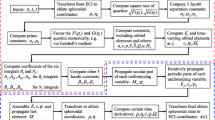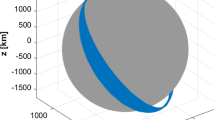Abstract
In the context of general perturbation theories, we analyze the motion of an artificial satellite around an Earth-like planet perturbed by the first eight zonal harmonic coefficients. By means of two Lie transforms and the Krylov-Bogoliubov-Mitropolsky method we produce a closed-form second-order analytical theory. Except for the critical inclination, this theory is valid for small eccentricities and inclinations. Two orbit propagators are derived from the analytical theory. The first, PPKBZ9\(\mathcal{A}\), is completely analytical whereas the second, PPKBZ9\(\mathcal{S}\mathcal{A}\), is based on numerical methods that compute the transformation of the variables. Prediction accuracy given by the orbit propagator programs is investigated by using data of different types of Earth and Mars orbiters. PPKBZ9\(\mathcal{A}\) can also be used by means of a friendly Web Interface in \(\mathcal{A}strody_{\mathcal{T}ools}^{\mathcal{W}eb}\) Web Site.
Similar content being viewed by others
References
BROUWER, D. “Solution of the Problem of Artificial Satellite Theory Without Drag,” Astronomical Journal, Vol. 64, 1959, pp. 379–397.
KOZAI, Y. “Second-Order Solution of Artificial Satellite Theory Without Air Drag,” Astronomical Journal, Vol. 67, 1962, pp. 446–461.
AKSNES, K. “A Second-Order Artificial Satellite Theory Based on an Intermediate Orbit,” Astronomical Journal, Vol. 75, 1970, pp. 1066–1076.
KINOSHITA, H. “Third-Order Solution of an Artificial Satellite Theory,” Smithsonian Astrophysical Observatory, Special Report No. 379, Cambridge, Massachusetts, 1977.
COFFEY, S.L. and DEPRIT, A. “Third-Order Solution to the Main Problem in Satellite Theory,” Journal of Guidance, Control, and Dynamics, Vol. 5, No. 4, 1982, pp. 366–371.
DEPRIT, A. “The Elimination of the Parallax in Satellite Theory,” Celestial Mechanics and Dynamical Astronomy, Vol. 24, No. 2, 1981, pp. 111–153.
COFFEY, S.L., DEPRIT, A. and DEPRIT, E. “Frozen Orbits for Satellites Close to an Earth-like Planet,” Celestial Mechanics and Dynamical Astronomy, Vol. 59, No. 1, 1994, pp. 37–72.
HEALY, L.M. “The Main Problem in Satellite Theory Revisited,” Celestial Mechanics and Dynamical Astronomy, Vol. 76, No. 2, 2000, pp. 79–120.
DEPRIT, A. “Delaunay Normalisations,” Celestial Mechanics and Dynamical Astronomy, Vol. 26, No. 1, 1982, pp. 9–21.
ALFRIEND, K.T. and COFFEY, S.L. “Elimination of the Perigee in the Satellite Problem,” Celestial Mechanics and Dynamical Astronomy, Vol. 32, No. 2, 1984, pp. 163–172.
HEALY, L.M. and TRAVISANO, J. “Automatic Rendering of Astrodynamics Expressions for Efficient Evaluation,” The Journal of the Astronautical Sciences, Vol. 46, No. 1, 1998, pp. 65–81.
SAN JUAN, J.F. Manipulación Algebraica de Series de Poisson. Aplicación a la Teoría del Satélite Artificial, Ph.D. Dessertation, University of Zaragoza, January 1996.
KRYLOV, N. and BOGOLIUBOV, N.N. Introduction to Nonlinear Mechanics, Princeton University Press, Princeton, New Jersey, 1947.
BOGOLIUBOV, N.N. and MITROPOLSKY, Y.A. Asymptotic Method in the Theory of Non-linear Oscillations, Gordon and Breach, New York, 1961.
CALVO, M. Aplicación del método de promedios al estudio del movimiento de satélites artificiales, Ph.D. Dessertation, University of Zaragoza, 1971.
CABALLERO, J.A. Movimiento de un satélite artificial bajo la acción gravitatoria terresre. Teoría de segundo orden en variables de Hill, Ph.D. Dessertation, University of Zaragoza, 1975.
SEIN-ECHALUCE, M. Estudio comparativo de intermediarios radiales y su aplicación a la teoría del satélite artificial zonal, Ph.D. Dessertation, University of Zaragoza, 1986.
SAN JUAN, J.F. “ATESAT: Automatization of Theories and Ephemeris in the Artificial Satellite Problem,” Centre National d’Etudes Spatiales, Technical Report No. CT/TI/MS/MN/94-250, Toulouse, France, 1994.
SAN JUAN, J. F. “ATESAT: Review and Improvements. Study of a Family of Analytical Models of the Artificial Satellite Generated by ATESAT and Their Numerical Validation versus PSIMU and MSLIB,” Centre National d’Etudes Spatiales, Technical Report No.DGA/T/TI/MS/MN/97-258, Toulouse, France, 1998.
ABAD, A. and SAN JUAN, J.F. “PSPC: A Poisson Series Processor Coded in C,” Dynamics and Astrometry of Natural and Artificial Celestial Bodies, Poznan, Poland, 1993, pp. 383–389.
SAN JUAN, J.F. and SERRANO, S. “Application of the Z6PPKB ATESAT-Model to Compute the Orbit of an Artificial Satellite Around Mars,” Centre National d’Etudes Spatiales, Technical Report No. DTS/MPI/MS/MN/2000-057, Toulouse, Francia, 2000.
ROH, K.-M., LUEHR, H., ROTHACHER, M., and PARK, S.-Y. “Investigating Suitable Orbits for the Swarm Constellation Mission — The Frozen Orbit,” Aerospace Science and Technology, Vol. 13, No. 1, 2009, pp. 49–58.
SAN JUAN, J.F. and LARA, M. “Normalizaciones de orden alto en el problema de Hill,” Monografías de la Real Academia de Ciencias de Zaragoza, Vol. 28, 2006, pp. 23–32.
SAN JUAN, J.F., ABAD, A., ELIPE, A. and TRESACO, E. “Analytical Model for Lunar Orbiter,” presented as paper AAS 2008-184 at the AAS/AIAA Space Flight Mechanics Meeting, Galveston, Texas, 2008.
KAMEL, A.A. “Perturbation Methods in the Theory of Nonlinear Oscillations,” Celestial Mechanics and Dynamical Astronomy, Vol. 3, No. 1, 1970, pp. 1, 90–106.
KIZNER, W. “A High Order Perturbation Theory Using Rectangular Coordinates,” presented as paper AIAA 63-391 at the American Institute of Aeronautics and Astronautics, Astrodynamics Conference, New Haven, Connecticut, August 1963.
BREITER, S. “On the Numerical Transformation of Variables in Perturbation Theory,” Celestial Mechanics and Dynamical Astronomy, Vol. 65, No. 4, 1997, pp. 345–354.
DEPRIT, A. “Canonical Transformations Depending on a Small Parameter,” Celestial Mechanics and Dynamical Astronomy, Vol. 1, No. 1, 1969, pp. 12–30.
HENRARD, J. “On a Perturbation Theory Using Lie Transform,” Celestial Mechanics and Dynamical Astronomy, Vol. 3, No. 1, 1970, pp. 107–120.
ABAD, A., SAN JUAN, J.F. and GAVÍN, A. “Short Term Evolution of Artificial Satellites,” Celestial Mechanics and Dynamical Astronomy, Vol. 79, No. 4, 2001, pp. 277–296.
DORMAND, J.R. and PRINCE, P.J. “Practical Runge-Kutta Processes,” SIAM Journal on Scientific and Statistical Computing, Vol. 10, No. 5, 1989, pp. 977–989.
JONES, J.P. and BECKERMAN, M. “Analysis of Errors in a Special Perturbations Satellite Orbit Propagator,” OAK Ridge National Laboratory, Technical Report No. ORNL/TM-13726, Oak Ridge, Tennessee, 1999.
LEMOINE, F.G., SMITH, D.E., ROWLANDS, D.D., ZUBER, M.T., NEUMANN, G.A., et al. “An Improved Solution of the Gravity Field of Mars (GMM-2B) From Mars Global Surveyor,” Journal of Geophysical Research, Vol. 106, No. 10, 2001, pp. 23, 359–23,376.
ESPOSITO, P., GRAAT, E., DEMCAK, S., BAIRD, D., and ALWAR, V. “Mars Global Surveyor: Mapping Orbit Evolution and Control Throughout One Mars Year,” presented as paper AAS 2001-40 at the AAS/AIAA Astrodynamics Specialist Conference, Quebec, Canada, 2001.
Author information
Authors and Affiliations
Additional information
Presented as paper AAS 09-157 at the 19th AAS/AIAA Spaceflight Mechanics Meeting. Savannah, Georgia, February 8–12, 2009.
Rights and permissions
About this article
Cite this article
San-Juan, J.F., Gavín, Á., López, L.M. et al. PPKBZ9\(\mathcal{A}, \mathcal{S}\mathcal{A}\) Two Orbit Propagators Based on an Analytical Theory. J of Astronaut Sci 58, 643–660 (2011). https://doi.org/10.1007/BF03321535
Published:
Issue Date:
DOI: https://doi.org/10.1007/BF03321535




